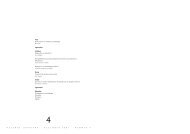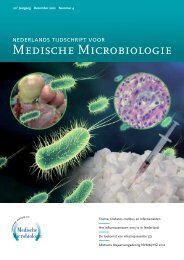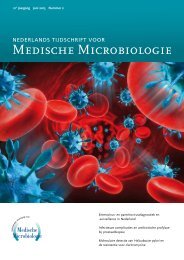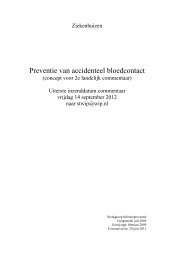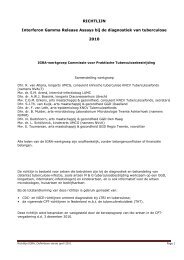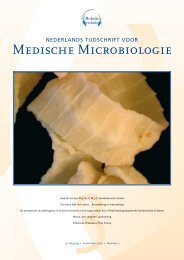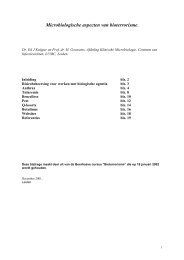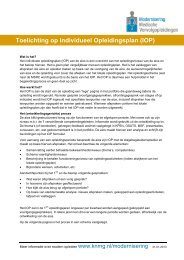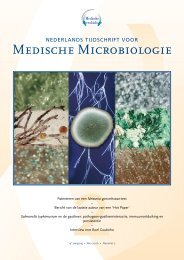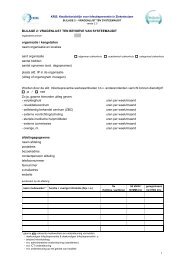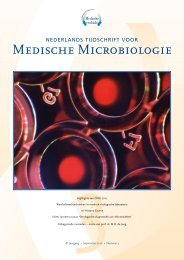Supplement bij veertiende jaargang, april 2006 - NVMM
Supplement bij veertiende jaargang, april 2006 - NVMM
Supplement bij veertiende jaargang, april 2006 - NVMM
You also want an ePaper? Increase the reach of your titles
YUMPU automatically turns print PDFs into web optimized ePapers that Google loves.
experiments with SSL5 and P-selectin-Fc chimera or<br />
antibodies directed against PSGL-1 were performed with<br />
human neutrophils. Functional role for SSL5 was investigated<br />
through rolling experiments with neutrophils<br />
under flow on a P-selectin surface. Influence of SSL5 on<br />
chemokine signaling was investigated in neutrophils and<br />
U937 cells through a calcium mobilization assay.<br />
Results: SSL5 inhibited binding of anti-PSGL-1 and Pselectin-Fc<br />
to neutrophils by 90% and 60%, respectively.<br />
SSL5 also strongly blocked adhesion and rolling of<br />
neutrophils to immobilized P-selectin under static and flow<br />
conditions comparably to anti-PSGL-1. Finally, SSL5 specifically<br />
inhibited the ? and Neutrophila-interleukin-8 (IL-8),<br />
growth-regulated oncogene alpha (GRO Activating Protein<br />
2 (NAP2)-induced calcium mobilization in neutrophils and<br />
U937 cells expressing the CXCR2.<br />
Conclusions:<br />
1) SSL5 binds PSGL-1 and interferes with PSGL-1-mediated<br />
binding to P-selectin under static and flow conditions.<br />
2) SSL5 inhibits CXCR2-induced cell activation.<br />
3) SSL5 is an important immunomodulatory protein of<br />
Staphylococcus aureus.<br />
05.04<br />
SCIn and CHIPS homologues are located on a new Immune<br />
evasion Cluster in S. aureus<br />
I. Jongerius, S.H.M. Rooijakkers, J.A.G. van Strijp<br />
UMC Utrecht, Eijkman-Winkler Institute, Utrecht<br />
Introduction: Staphylococcal Complement Inhibitor (SCIN)<br />
and Chemotaxis Inhibitory Protein of Staphylococci<br />
(CHIPS) are crucial for the staphylococcal defense against<br />
our innate immune system. SCIN and CHIPS are located<br />
on the first Immune Evasion Cluster (IEC) in Staphylococcus<br />
aureus. A BLAST search revealed four unknown staphylococcal<br />
proteins with high sequence homology to SCIN<br />
or CHIPS. SCIN-B and SCIN-C, sharing 45% and 48%<br />
homology with SCIN, also function as complement<br />
inhibitors. The CHIPS-like proteins, Formylated Peptide<br />
Receptor Like-1 (FPRL-1) Inhibitory protein (FLIPr) (28%<br />
homology) and FLIPr-like (77% homology with FLIPr)<br />
prevent activation of FPRL-1 or FPR&FPRL-1 respectively.<br />
In this study we describe the unique location of SCIN and<br />
CHIPS homologues on a new Immune Evasion Cluster<br />
(IEC2) in S. aureus.<br />
Methods: Database analyses were performed to characterize<br />
IEC2. The prevalence of SCIN-B, SCIN-C, FLIPr, FLIPr-like<br />
and neighboring genes in 90 clinical S. aureus strains was<br />
determined by PCR. For functional analyses, we cloned and<br />
expressed the protein with 33% homology to Extracellular<br />
Fibrinogen Binding protein (Efb) (Efb-like) in Escherichia<br />
coli. Efb-like was tested in whole blood phagocytosis assays<br />
Ned Tijdschr Med Microbiol <strong>2006</strong>; 4:<strong>Supplement</strong><br />
S23<br />
using FITC-labeled S. aureus. Calcium mobilization was<br />
performed to study effects on C5a production.<br />
Results: We describe a new Immune Evasion Cluster<br />
(IEC2) in S. aureus that carries the genes for SCIN-B (46%<br />
of strains) or SCIN-C (33%), FLIPr (79%) or FLIPr-like<br />
(4%), Alpha-toxin (100%), Efb (86% C3b modulator), Efblike<br />
(58%), an unknown membrane protein (90%) and 3<br />
putative exotoxins (93%). Efb-like was identified as a potent<br />
immune evasion molecule since it effectively prevents<br />
phagocytosis in whole blood. Since Efb-like prevents<br />
generation of C5a, it is a new complement modulator.<br />
Conclusion:<br />
1) The immune evasion molecules SCIN-B, SCIN-C, FLIPr<br />
and FLIPr-like are located on a new Immune Evasion<br />
Cluster (IEC2) in S. aureus.<br />
2) On this IEC2 we also found the genes for Alpha-toxin,<br />
Efb, 4 unknown proteins and Efb-like.<br />
3) Efb-like represents a new complement modulator in<br />
S. aureus.<br />
05.05<br />
Complement inhibition by S. aureus<br />
S.H.M. Rooijakkers1 , M. Ruyken1 , A. Roos2 , M.R. Daha2 ,<br />
J.S. Presanis3 , R.B. Sim3 , W.J.B. van Wamel1 , K.P.M. van<br />
Kessel1 , J.A.G. van Strijp1 1 2 UMC Utrecht, Eijkman-Winkler Institute, Utrecht, Department<br />
of Nephrology, University Medical Center, Leiden, 3MRC Immunochemistry Unit, Department of Biochemistry,<br />
University of Oxford, UK.<br />
The complement system plays a pivotal role in host<br />
defense but also contributes to tissue injury in several<br />
diseases. Here we describe the discovery of Staphylococcal<br />
Complement Inhibitor (SCIN), an excreted 9.8 kD protein<br />
that blocks human complement by specific interaction<br />
with C3 convertases (C4b2a and C3bBb). The assembly<br />
of C3 convertases (C4b2a and C3bBb) is a prerequisite<br />
for complement activation. The convertases catalyze C3b<br />
deposition on activator surfaces. SCIN binds and stabilizes<br />
C3 convertases, interfering with C3b deposition via the<br />
classical, lectin and alternative complement pathway. This<br />
leads to a dramatic decrease in phagocytosis and killing of<br />
Staphylococcus aureus by human neutrophils. As a highly<br />
active and small soluble protein that acts exclusively on<br />
surfaces, SCIN is a promising anti-inflammatory molecule.<br />
Furthermore, we address the role of other staphylococcal<br />
proteins that modulate the complement system.



